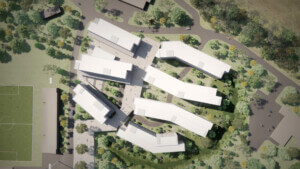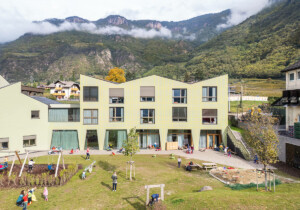Jury’s Choice
This year’s jury consisted of:
Danny Adams, Principal, LS3P Associates
Marsha Maytum, Principal, Leddy Maytum Stacy Architects
Eric McDonnell, Principal, Holmes Structures
Matt Shaw, Contributing Editor, The Architect’s Newspaper
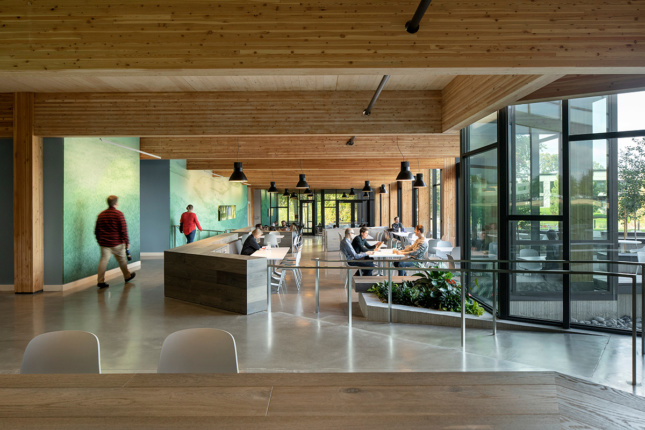
Project: First Tech Federal Credit Union
Location: Hillsboro, Oregon
Architect: Hacker
Structural Engineer: Kramer Gehlen & Associates
Contractor: Swinerton Builders
First Tech Federal Credit Union’s motto is People First—and its new Oregon campus is designed to support and promote the health, comfort, and happiness of employees. Open offices are designed with an emphasis on equal access to natural light and views, and work stations are arranged to ensure that all employees can benefit from biophilic opportunities. Much of the building’s design draws on the beauty of the wood structural system, which is visible throughout the building. Glulam columns and beams frame floor-to-ceiling views to the park and the creek that surrounds the site on three sides. Raised floors conceal HVAC, electrical, and low-voltage systems, contributing to clear, uncluttered spaces that showcase the simple beauty of the cross-laminated timber ceilings. On the ground floor, a central commons with stadium-style seating ascends into a double-height atrium capable of accommodating large gatherings and presentations. LEED Gold-certified, the building achieved an exemplary score in the regional materials category as all of the columns, beams, and CLT panels were sourced and refined within 500 miles of the site. 156,000 square feet / Type III-A construction
Multi-Family Wood Design
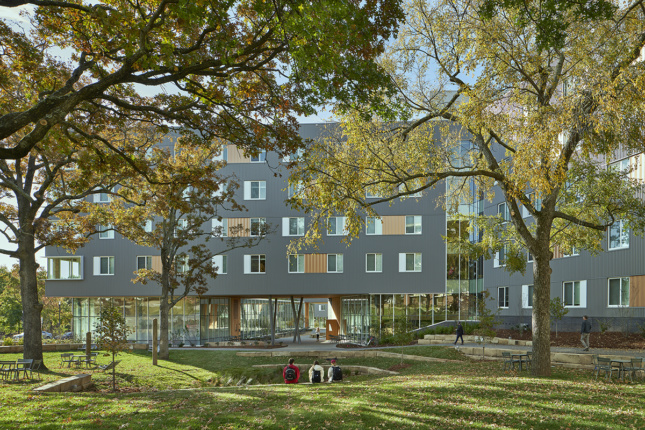
Project: Adohi Hall
Location: Fayetteville, Arkansas
Architect: Leers Weinzapfel Associates; modus studio (AOR); Mackey Mitchell Architects
Structural Engineer: Equilibrium Consulting; Engineering Consultants, Inc.
Contractor: Nabholz Construction
Adohi Hall at the University of Arkansas is the nation’s first large-scale mass timber student housing facility. A bold demonstration of sustainability, the 708-bed complex includes three main volumes, linked together to create a serpentine form set into a sloped site. Buildings A and B include five stories of mass timber—a cross-laminated timber floor and ceiling system supported by glulam columns and beams—over a concrete podium and partial basement. Building C is a one-story volume linking the two residential buildings. Maintaining acoustical separation was a significant issue. To expose the CLT ceilings, acoustical treatment was concentrated on top of the panels. To minimize the depth of the panel topping, and thus the floor-to-floor height, the team used an ultra-thin sound attenuation mat topped with less than 2 inches of heavyweight gypcrete and luxury vinyl tile planks—which surpassed the required STC rating of 50 between sleeping quarters. The use of wood both structurally and aesthetically makes this project a groundbreaking example of student housing design. 202,000 square feet / Type III-B construction
Commercial Mid-Rise
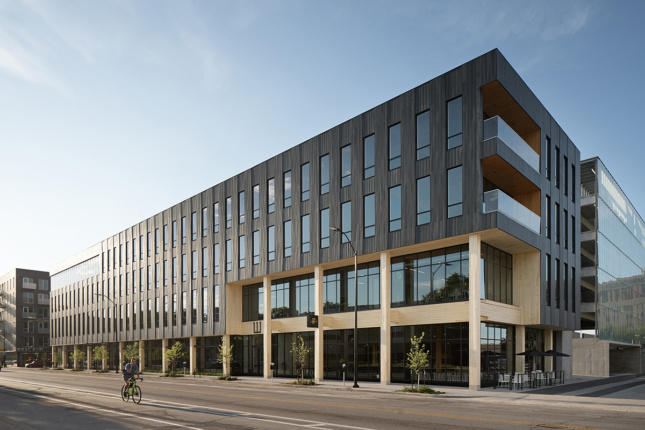
Project: 111 East Grand
Location: Des Moines, Iowa
Architect: Neumann Monson Architects
Structural Engineer: Raker Rhodes Engineering, StructureCraft
Contractor: Ryan Companies
Anchoring a high-visibility site in Des Moines’ historic East Village, 111 East Grand includes three stories of offices above retail and restaurant spaces on the ground floor. It is the first multi-story office building to include floor and roof decks made from dowel-laminated timber. The DLT panels are supported by glulam post-and-beam framing, and the building is buttressed by a concrete core on the south face for lateral stability. Leveraging a unique benefit of mass timber, much of the structure is left exposed on the interior. This minimizes the need for tenant improvement while providing visual, tactile, and olfactive stimulation to the building’s occupants. Operable windows allow natural ventilation, and balconies on the west provide downtown views. The project is innovative in both design and delivery. From the outset, the core design team of architect and structural engineer collaborated closely with the mass timber engineers and general contractor. This enabled 111 East Grand to push boundaries and convey the accessibility of mass timber building design through its ultimate success. 66,000 square feet / Type III-B construction
Commercial Low-Rise
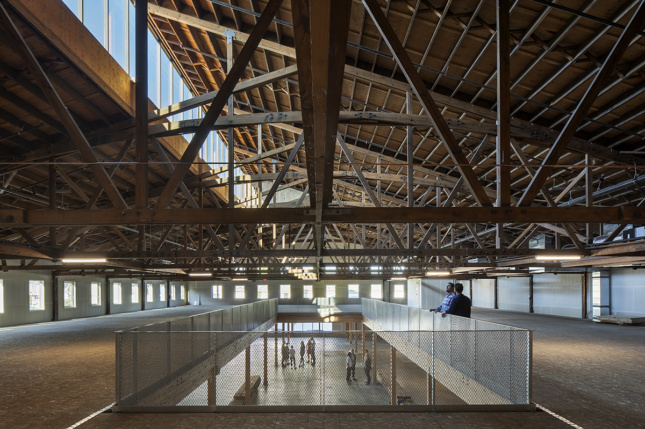
Project: Redfox Commons
Location: Portland, Oregon
Architect: LEVER Architecture
Structural Engineer: KPFF Consulting Engineers
Contractor: R&H Construction
This adaptive reuse project transforms a pair of World War II-era warehouses into a light-filled campus for creative office tenants. Recognizing the historic and environmental significance of the existing wood structures, the renovation preserves and restores the original lumber. The trusses were sandblasted and remain exposed, highlighting the wood’s natural beauty. New 80-foot-wide clerestory windows were added to each roof to bring light into the large open floor plates, which are distinguished by column-free spans of 100 feet. To uphold the project’s heritage, both buildings were rebuilt using an industrial vernacular of ribbon windows and weathering steel cladding. During demolition, wood from an overbuilt mezzanine was salvaged to create a new timber and glass entrance structure that connects the two buildings. Over 6,500 linear feet of 4-by-12-inch boards were reclaimed, varying in length from 12 to 24 feet. The boards were fastened around new glulam members using large wood screws to create distinctive columns and beams. This innovative use of wood creates a welcoming entry that is expressive of both the project’s heritage and environmentally-conscious design. 60,000 square feet / Type III-B construction
Wood in Government Buildings
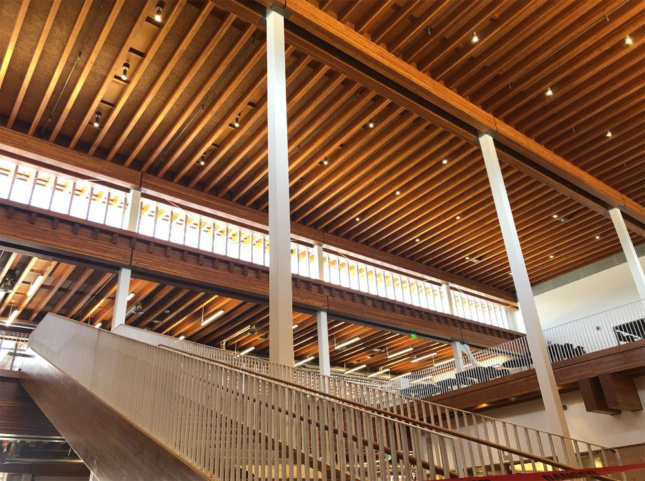
Project: Long Beach Civic Center—Billie Jean King Main Library
Location: Long Beach, California
Architect: SOM ǀ Skidmore, Owings & Merrill
Structural Engineer: SOM ǀ Skidmore, Owings & Merrill
Contractor: Clark Construction
Installer: WS Klem
Located adjacent to historic Lincoln Park, the Billie Jean King Main Library provides a welcoming and flexible environment, with interior space organized into discrete and identifiable areas that maximize the use of square footage while enhancing accessibility. Built over an existing parking structure, the hybrid building includes an exposed glulam roof system over steel framing. It offers a variety of spaces, including group study rooms, independent study areas, a technology-driven makerspace, community center, and large central atrium that provides abundant natural light. Targeting LEED certification, the building also features rooftop photovoltaic cells, daylighting strategies, controlled air ventilation systems, and extensive glazing with architectural overhangs for solar protection. The library is part of the Long Beach Civic Center Master Plan, designed by SOM to revitalize 22 acres of downtown Long Beach by creating a vibrant, mixed-use district. 96,000 square feet / Type IV construction
Wood in Schools
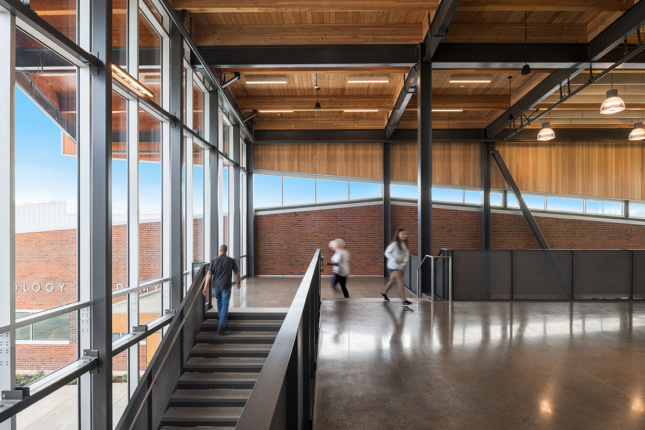
Project: Arts and Technology Academy
Location: Eugene, Oregon
Architect: Opsis Architecture; Rowell Brokaw Architects (AOR)
Structural Engineer: catena consulting engineers
Contractor: Hyland Construction
As a teaching tool for middle school students to explore and learn about the interaction between the natural and built world, the Arts and Technology Academy’s honest and tectonic expression of structure, exposed building systems, natural materials, and daylighting create a physical environment conducive to a STE(A)M-centric curriculum. An iconic, umbrella-like folding roof comprised of steel frames, glulam beams, and wood decking—all left exposed—stretches across the length of the building above continuous clerestory windows. Appearing to float, it cantilevers in various locations, offering protection from the elements while creating a warm and inviting interior environment. Various sloped roof profiles pay homage to the surrounding residential vernacular while visually bridging the scale of the project’s two-story massing and surrounding one-story homes. An expansive photovoltaic array adorns the south-facing roof. Ample exterior glazing maximizes daylight and views during the day while serving as a warmly-lit community beacon at night. 95,718 square feet / Type IIIB construction
Institutional
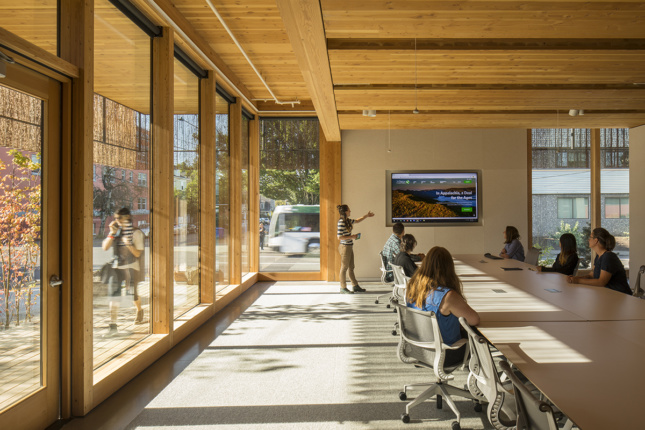
Project: Oregon Conservation Center
Location: Portland, Oregon
Architect: LEVER Architecture
Structural Engineer: KPFF Consulting Engineers
Contractor: Lease Crutcher Lewis
A blend of mass timber and light wood-frame construction, this renovation and expansion of The Nature Conservancy’s Oregon headquarters transforms a dated office building into a collaborative hub that reflects the environmental mission of its owner. Central to the upgrade is the addition of a 2,000-square-foot ground-level pavilion that serves as a gathering space for public events and collaborations. The building achieved LEED Gold certification, with features that include domestically-fabricated and FSC-certified cross-laminated timber panels, rooftop photovoltaics that produce 25 percent of the building’s electrical supply, efficient building systems and fixtures that reduce electricity consumption by 54 percent and water consumption by 44 percent, and a landscaping and subsurface filtration system to manage stormwater. Abundant daylighting, operable windows, and the use of local materials enhance comfort and connect occupants to the neighborhood and greater region. 15,000 square feet / Type VB construction
Green Building with Wood
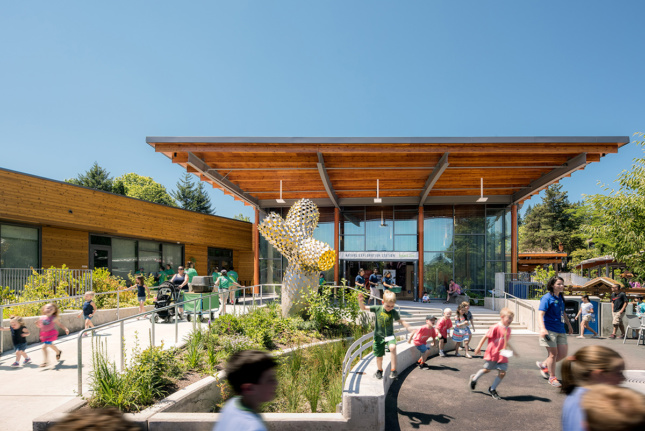
Project: Oregon Zoo Education Center
Location: Portland, Oregon
Architect: Opsis Architecture; Jones and Jones (zoo design; insect zoo architect)
Structural Engineer: catena consulting engineers
Contractor: Fortis Construction
Guided by the Zoo’s central theme, Small Things Matter, the design of this LEED Platinum-certified Education Center brings together a number of architectural and exhibition elements to create teachable, sustainable moments. Built with a combination of heavy timber, light wood framing, and steel, the two single-story buildings are inspired by the circular, woven nature of a bird’s nest; the resulting architecture creates an intertwined relationship between indoor and outdoor spaces that blends into the zoo’s landscape and exhibits. The sweeping cantilevered glulam entry roof and cedar-clad exterior draw visitors into the lobby’s interactive displays, insect exhibit, and event space. Sustainable design strategies include an expansive rooftop photovoltaic array, rain gardens with 90 species of native plants that provide wildlife habitat while cleaning stormwater for reuse, bird-friendly lighting, and fritted glass windows. The Center is expected to achieve net-zero energy certification. 20,000 square feet / Type V-B construction
Beauty of Wood
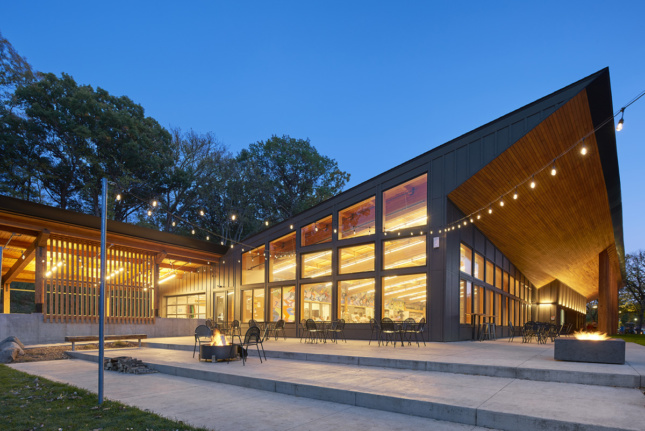
Project: Trailhead Building at Theodore Wirth Park
Location: Minneapolis, Minnesota
Architect: HGA
Structural Engineer: HGA
Contractor: Kalcon
A gateway to the Nordic ski and mountain bike trails of the Minneapolis Parks System, the trailhead building is used extensively by the public and area high schools for training and competitive meets. The highlight is an innovative mass timber roof that cantilevers in two orthogonal directions, tapers to a point at its tip, and is fully exposed on the interior. Glulam girders cantilever from 10 to 25 feet, following the trapezoidal shape of the roof, and are supported in part by a colonnade of Douglas-fir glulam columns and wood-frame walls. The unique roof and colonnade provide an elegant entry, while exposed wood on the interior creates a natural connection between gathering spaces and the outdoors. While embracing its surroundings with the use of mass timber, this building has also been embraced by its community. It was chosen as a hosting facility for the 2020 Cross Country Ski World Cup. 14,200 square feet / Type V-A construction
Adaptable and Durable Wood Structures
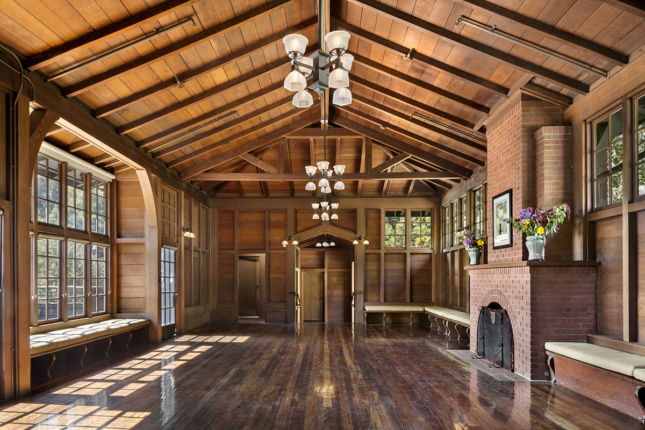
Project: Julia Morgan Hall
Location: Berkeley, California
Architect: Siegel & Strain Architects
Structural Engineer: Bluestone Engineering
Contractor: James R. Griffin
Built in 1911, this Senior Women’s Hall at UC Berkeley is an elegant redwood bungalow with exposed wall and roof framing and a natural-finish interior. The building served as a gathering place for female students until 1969, when it was converted into a childcare center. First relocated in 1946, it was moved again in 2014—to the UC Berkeley Botanical Garden. To extricate the structure from its site and negotiate a winding road with overhanging trees, the building was divided into four segments, which were reassembled at the Garden, rehabilitated, and upgraded to meet current accessibility standards. All of the work—including cutting, installation, subsequent removal of temporary shoring and protection, and reassembly—had to be carefully executed to avoid damage. The exposed interior wood components required only minimal staining to conceal wear and tear, while the rich wood floors were refinished. The redwood siding was replaced as required and painted, and the team added a new wood porch. 2,255 square feet / Type V-B construction
Regional Excellence Awards
Project: 901 East Sixth
Location: Austin, Texas
Architect: TB/DS (Thoughtbarn/Delineate Studio)
Structural Engineer: Leap!Structures
Contractor: DCA Construction
A design goal for this five-story office building was to make it seem at home in the creative, light industrial neighborhood of East Side Austin. The structure is a hybrid of exposed cross-laminated timber floor and ceiling systems, and exposed steel—and is the first of its kind in Texas. It is clad in Corten steel, which forms a stable, rust-like appearance over time. A double-height lobby with a 25-foot bi-fold door allows the space to be opened to the street during special events; it also serves as a showcase for the exposed wood ceiling and full-height feature wall made from CLT off-cuts. 901 East Sixth achieved LEED Gold certification and was fully leased before construction was complete—at rates significantly exceeding the original pro forma. The project has been a celebrated financial success for its developers while receiving an enthusiastic reception from the public. 128,000 square feet / Type III-A construction
Project: CoǀLab
Location: Falls Church, Virginia
Architect: William McDonough + Partners
MEP Engineer: Staengl Engineering
Contractor: HITT Contracting
This unique project is intended to serve as a nucleus for research and testing of emerging technologies, products, and practices that will transform the construction industry. HITT Contracting envisioned Co|Lab as a showcase for building innovation that would utilize as many healthy materials as possible and exhibit smart emerging design and construction technologies. The mass timber structure—which includes cross-laminated timber walls and ceilings supported by glulam columns and beams—was chosen for its aesthetic, multi-sensory characteristics, light carbon footprint, and speed of construction. The design is based on cradle-to-cradle principles; instead of minimizing the building’s negative environmental footprint, the team wanted a beneficial footprint. Co|Lab is LEED Platinum-certified, and HITT is pursuing both Net Zero Energy and Petal certification. It was the first CLT structure in Virginia and the first commercial mass timber building in metropolitan DC. 8,650 square feet / Type V-B construction
Project: The Continuum
Location: Lake City, South Carolina
Architect: McMillan Pazdan Smith Architecture
Structural Engineer: Britt Peters & Associates
Contractor: Thompson Turner Construction
The Continuum is an innovative campus serving college, continuing education, and high school students in northeast South Carolina. After exploring options, the design team chose to renovate an existing big-box retail shell adjacent to downtown Lake City—but they added a unique structural solution. The roof of the central corridor was replaced with a large mass timber structure. Comprised of glulam columns and beams and nail-laminated timber decking, the addition allows daylight to penetrate to the center of the former retail floor. From the site plan and exterior façade to the interior finishes, the design is inspired by the imagery of the region’s deconstructed barns. As visitors approach the plaza, the view down the road reaches a reflection pool that runs under an extended overhang of the soaring NLT deck and into a green space intended for art installations. By strategically dividing and removing some of the existing structure with the glulam clerestory, the design creates circulation spaces flooded with light that invite students to gather. Linked by these open spaces, the building incorporates multiple educational functions into one cohesive floor plan. 46,592 square feet / Type IV construction
Project: MFAH Sarah Campbell Blaffer Foundation Center for Conservation
Location: Houston, Texas
Architect: LakeǀFlato Architects; Kendall/Heaton Architects (AOR)
Structural Engineer: Cardno Haynes Whaley
Contractor: WS Bellows
Wood Structure & Engineering Consultant: StructureCraft Builders
Art conservation facilities tend to be thought of as sterile laboratory spaces, but that isn’t true of this one. From the outset, the design team wanted to incorporate natural biophilic materials, specifically wood, to provide an appropriate warmth and texture to the laboratory environment. This hybrid project includes glulam columns and beams and dowel-laminated timber roof panels, as well as steel structural elements. The DLT roof is left exposed, offering a welcome contrast to the wall finishes that are necessarily neutral. The overall result blends the science and art of conservation to create spaces that perform superbly to their technical requirements while offering a warm and welcoming work environment for the art conservators. 30,000 square feet / Type IV construction
Project: DPR Office
Location: Sacramento, California
Architect: SmithGroup
Structural Engineer: Buehler Engineering
Contractor: DPR Construction
When DPR Construction decided to relocate its office to downtown Sacramento, it was seeking to connect with the community it serves on a deeper level. In choosing mass timber, it also saw an opportunity to give employees the benefits of a biophilic design and enhance their workday experience. The project, which involved adding a second story to a 1940s-era concrete and masonry building, includes cross-laminated timber roof and wall panels, and glulam columns and beams. Among its unique features, the building includes CLT shear walls, a first in California. It also exceeds regulatory requirements, targeting net-positive energy—which reduces its carbon footprint from the standpoint of operations and maintenance. The use of mass timber augments this goal by reducing embodied carbon and acting as a carbon sink. This is DPR’s sixth net-zero energy office, and the firm is seeking LEED Platinum, Petal, and WELL Building certifications. 34,508 square feet / Type V-B construction
Project: Pike Place Marketfront
Location: Seattle, Washington
Architect: The Miller Hull Partnership
Structural Engineer: Magnusson Klemencic Associates
Contractor: Sellen Construction
Pike Place MarketFront adds 50 vendor stalls; 40 low-income and senior apartments; commercial, retail and office space; a public roof terrace and walkways; and 300 underground parking spaces to the Pike Place Market Historic District in Seattle. Comprised primarily of heavy timber, light wood framing, and cast-in-place concrete, the project draws contextual inspiration from the simple utilitarian character of the existing market. This historic precedent, combined with timber’s carbon-negative footprint, abundant local sourcing, and speed of erection, made it an easy choice for the project team. While timber is typically used to support gravity loads, the structural engineer designed composite timber and steel framing members to manage portions of the building’s lateral loads. Enclosed by a timber-frame glazing system, the monumental structure includes a vibrant hall housing retail and restaurant spaces while preserving historic views of Puget Sound. Heavy timber columns, beams, and decking serve as both structure and finish, bringing the natural beauty of wood to the space. 210,000 square feet / Type IV construction
Project: Rhode Island School of Design – North Hall
Location: Providence, Rhode Island
Architect: NADAAA
Structural Engineer: Odeh Engineers
Contractor: Shawmut Design and Construction
For this six-story residence hall at RISD, the design team chose a hybrid system of cross-laminated timber floor and ceiling panels supported by steel framing to achieve goals that included beautiful design, environmental sustainability, and an aggressive construction schedule. Exposed CLT ceilings add beauty while echoing themes of sustainability that students experience as part of the school’s curriculum. In addition to reducing the project’s carbon footprint through the use of CLT, the new hall is expected to use a quarter less energy and less than half the water of a typical residential structure of similar size. The system also provided a schedule advantage. Working closely with the fabricator, the team optimized the layout of panels to minimize erection time. Five-ply panels were manufactured in 8-by-50-foot spans—allowing a single panel to span the building’s width. The erector exceeded expectations by completing the superstructure in less than three weeks. By prioritizing innovation and working to achieve a shared vision, the RISD project team successfully brought the first hybrid CLT-steel residence hall in New England to life. 40,790 square feet / Type III-B construction
Project: Sideyard
Location: Portland, Oregon
Architect: Skylab
Structural Engineer: catena consulting engineers
Contractor: Andersen Construction
Photos: Stephen Miller
When the City of Portland built a new one-way couplet connecting to the Burnside Bridge, it created a leftover berm space that is now home to Sideyard. Shaped like a wedge, this five-story project prioritizes access to public transportation, bicycle access, and pedestrian openness. It includes retail and restaurant space at street level, additional retail on the second floor, and office space above. The structure includes a cross-laminated timber floor and roof system supported by a glulam post-and-beam frame, with concrete lateral cores. Sideyard is part of the new Central Eastside community envisioned in the Burnside Bridgehead Framework Plan, designed to strengthen the connectivity of the area with the Westside downtown core. Its use of locally-sourced materials showcases Oregon wood species in a truly unique fashion. 23,202 square feet / Type III-A construction
Project: Tre Søstre
Location: Grand Marais, MMinnesota
Architect: Salmela Architect
Structural Engineer: Meyer Borgman Johnson
Contractor: Taiga Design + Build
Tre Søstre is located in a former fishing village, close to the shore of Lake Superior. Two decades ago, the owners purchased the abandoned property, converted three severely damaged buildings into rental units, and built a heavy timber “boathouse” as their own live/work space. They recently added three units—designed to make a bold statement while remaining sensitive to the scale and materials of the neighborhood. Despite modest footprints, the structures include multiple cantilevered volumes and decks, a strategy inspired by Scandinavian farm buildings. Each unit has a covered entry deck located above grade. Interior stairs lead down to ground-level and up to second-floor bedrooms. The top floors cantilever to the east, creating an open living space with unobstructed views while providing cover for the patios and decks off the bedrooms below. Spatial adjacencies were carefully considered to provide areas of protected privacy and open gathering within a relatively dense cluster of units. 3,440 square feet / Type V-B construction









